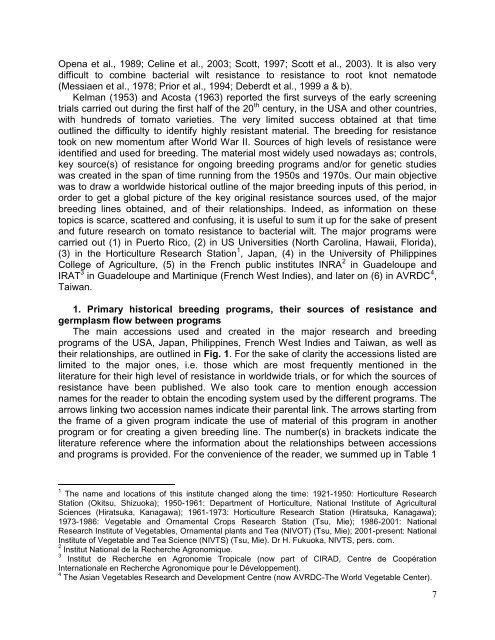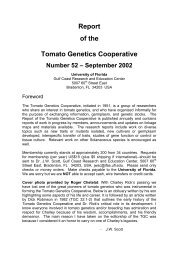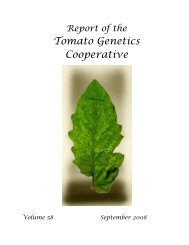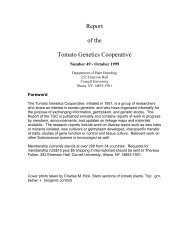Volume 60 - Tomato Genetics Cooperative - University of Florida
Volume 60 - Tomato Genetics Cooperative - University of Florida
Volume 60 - Tomato Genetics Cooperative - University of Florida
You also want an ePaper? Increase the reach of your titles
YUMPU automatically turns print PDFs into web optimized ePapers that Google loves.
Opena et al., 1989; Celine et al., 2003; Scott, 1997; Scott et al., 2003). It is also very<br />
difficult to combine bacterial wilt resistance to resistance to root knot nematode<br />
(Messiaen et al., 1978; Prior et al., 1994; Deberdt et al., 1999 a & b).<br />
Kelman (1953) and Acosta (1963) reported the first surveys <strong>of</strong> the early screening<br />
trials carried out during the first half <strong>of</strong> the 20 th century, in the USA and other countries,<br />
with hundreds <strong>of</strong> tomato varieties. The very limited success obtained at that time<br />
outlined the difficulty to identify highly resistant material. The breeding for resistance<br />
took on new momentum after World War II. Sources <strong>of</strong> high levels <strong>of</strong> resistance were<br />
identified and used for breeding. The material most widely used nowadays as; controls,<br />
key source(s) <strong>of</strong> resistance for ongoing breeding programs and/or for genetic studies<br />
was created in the span <strong>of</strong> time running from the 1950s and 1970s. Our main objective<br />
was to draw a worldwide historical outline <strong>of</strong> the major breeding inputs <strong>of</strong> this period, in<br />
order to get a global picture <strong>of</strong> the key original resistance sources used, <strong>of</strong> the major<br />
breeding lines obtained, and <strong>of</strong> their relationships. Indeed, as information on these<br />
topics is scarce, scattered and confusing, it is useful to sum it up for the sake <strong>of</strong> present<br />
and future research on tomato resistance to bacterial wilt. The major programs were<br />
carried out (1) in Puerto Rico, (2) in US Universities (North Carolina, Hawaii, <strong>Florida</strong>),<br />
(3) in the Horticulture Research Station 1 , Japan, (4) in the <strong>University</strong> <strong>of</strong> Philippines<br />
College <strong>of</strong> Agriculture, (5) in the French public institutes INRA 2 in Guadeloupe and<br />
IRAT 3 in Guadeloupe and Martinique (French West Indies), and later on (6) in AVRDC 4 ,<br />
Taiwan.<br />
1. Primary historical breeding programs, their sources <strong>of</strong> resistance and<br />
germplasm flow between programs<br />
The main accessions used and created in the major research and breeding<br />
programs <strong>of</strong> the USA, Japan, Philippines, French West Indies and Taiwan, as well as<br />
their relationships, are outlined in Fig. 1. For the sake <strong>of</strong> clarity the accessions listed are<br />
limited to the major ones, i.e. those which are most frequently mentioned in the<br />
literature for their high level <strong>of</strong> resistance in worldwide trials, or for which the sources <strong>of</strong><br />
resistance have been published. We also took care to mention enough accession<br />
names for the reader to obtain the encoding system used by the different programs. The<br />
arrows linking two accession names indicate their parental link. The arrows starting from<br />
the frame <strong>of</strong> a given program indicate the use <strong>of</strong> material <strong>of</strong> this program in another<br />
program or for creating a given breeding line. The number(s) in brackets indicate the<br />
literature reference where the information about the relationships between accessions<br />
and programs is provided. For the convenience <strong>of</strong> the reader, we summed up in Table 1<br />
1 The name and locations <strong>of</strong> this institute changed along the time: 1921-1950: Horticulture Research<br />
Station (Okitsu, Shizuoka); 1950-1961: Department <strong>of</strong> Horticulture, National Institute <strong>of</strong> Agricultural<br />
Sciences (Hiratsuka, Kanagawa); 1961-1973: Horticulture Research Station (Hiratsuka, Kanagawa);<br />
1973-1986: Vegetable and Ornamental Crops Research Station (Tsu, Mie); 1986-2001: National<br />
Research Institute <strong>of</strong> Vegetables, Ornamental plants and Tea (NIVOT) (Tsu, Mie); 2001-present: National<br />
Institute <strong>of</strong> Vegetable and Tea Science (NIVTS) (Tsu, Mie). Dr H. Fukuoka, NIVTS, pers. com.<br />
2 Institut National de la Recherche Agronomique.<br />
3 Institut de Recherche en Agronomie Tropicale (now part <strong>of</strong> CIRAD, Centre de Coopération<br />
Internationale en Recherche Agronomique pour le Développement).<br />
4 The Asian Vegetables Research and Development Centre (now AVRDC-The World Vegetable Center).<br />
7





